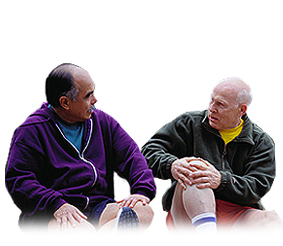Knee Pain SmartSiteTM | ||||||||||||||||||
Going home after knee replacement surgeryDescriptionYou had knee joint replacement surgery to replace all or part of your knee with an artificial joint. This artificial joint is called a prosthesis. Activity when you go homeBy the time you go home, you should be able to walk with a walker or crutches without needing much help. Use your crutches or walker for as long as you need them. Most people do not need them after 4 to 6 weeks. You should also be able to dress yourself with only a little help and be able to get into and out of your bed or a chair by yourself. You should be able to use the toilet without much help. Keep moving and walking once you get home. DO NOT put weight on your side with the new knee until your doctor tells you it is okay. Start out with short periods of activity, and then gradually increase them. Your doctor or physical therapist will give you exercises to do at home. After a few days you may be able to do simple household chores. DO NOT try to do heavier chores, such as vacuuming or laundry. Remember, you will get tired quickly at first. It's important to take care with your new knee joint. You need to be careful that you do not dislocate your artificial knee. This is especially true in the first few months after surgery. You will need to learn exercises that make your new knee stronger. Getting the home ready and safeYou will need to have someone with you at home 24 hours a day for 7 to 10 days after you leave the hospital or rehab center. You will need help preparing meals, bathing, moving around the house, and doing other daily activities. Before your surgery, make sure you have enough help once you come home. Also take steps to get your home ready after surgery. Self-careControlling your pain when home:
As you have an artificial knee joint, you need to carefully protect yourself against infection. You will need to take antibiotics before any invasive medical procedures. Make sure your health care providers know about your prosthesis. In the past providers recommended antibiotics for dental procedures, like teeth cleaning. However, the recommendation has changed, and this is not required. Most surgeons do not want you to have any surgical procedures done within 3 months of your replacement, unless it is necessary. Always check with your doctor first before you visit your dentist or have another type of procedure. Your doctor will tell you when it is okay to start sexual activity again. Usually this will be 4 to 6 weeks after surgery. Most positions used before surgery should still be comfortable. Follow-up tests and visits may be scheduled before you leave the hospital. If not, call and schedule a follow-up with your orthopedic surgeon. To reduce swelling:
Feeling sad or depressedYou may feel sad or depressed when first coming home from the hospital. Friends or family may notice you are more irritable or you cry more easily. These feelings and behaviors are normal and not anything to worry about. You should understand you have been through a major operation and are working hard to recover. If feelings of sadness are severe or become worse, contact your doctor or nurse. When to call the doctorCall your doctor or nurse if you have:
Call the doctor if your foot or toes look darker than normal or are cool to the touch. | ||||||||||||||||||
| ||||||||||||||||||
Review Date: 5/3/2016 Reviewed By: C. Benjamin Ma, MD, Professor, Chief, Sports Medicine and Shoulder Service, UCSF Department of Orthopaedic Surgery, San Francisco, CA. Also reviewed by David Zieve, MD, MHA, Isla Ogilvie, PhD, and the A.D.A.M. Editorial team. View References:  The information provided herein should not be used during any medical emergency or for the diagnosis or treatment of any medical condition. A licensed medical professional should be consulted for diagnosis and treatment of any and all medical conditions. Links to other sites are provided for information only -- they do not constitute endorsements of those other sites. No warranty of any kind, either expressed or implied, is made as to the accuracy, reliability, timeliness, or correctness of any translations made by a third-party service of the information provided herein into any other language. © 1997- A.D.A.M., a business unit of Ebix, Inc. Any duplication or distribution of the information contained herein is strictly prohibited. | ||||||||||||||||||
A.D.A.M. content is best viewed in IE9 or above, Firefox and Google Chrome browser. | ||||||||||||||||||












